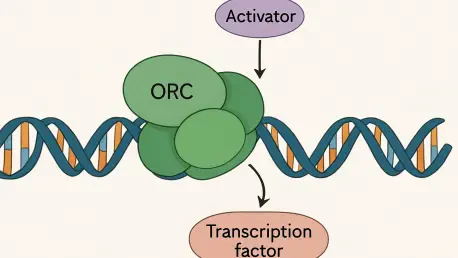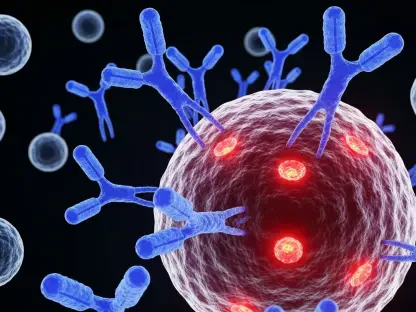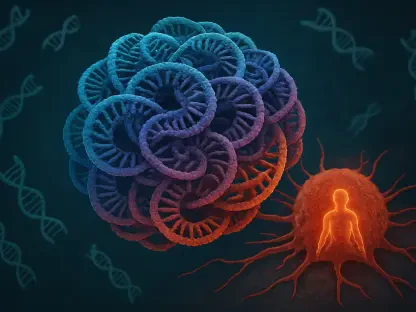Imagine a cellular mechanism so fundamental to life that it not only kickstarts DNA replication but also holds the reins of gene expression, dictating which genetic instructions are read or silenced in human cells. The origin-recognition complex (ORC), long understood as the spark for DNA copying, is now revealing itself as a master regulator of genomic activity. This surprising duality has ignited intense discussion among molecular biologists and epigenetic researchers. This roundup gathers diverse perspectives, tips, and analyses from multiple sources to explore how ORC influences gene regulation far beyond its traditional role, aiming to illuminate the latest findings and debates in this evolving field.
Diverse Perspectives on ORC’s Expanded Regulatory Functions
Subunit-Specific Actions: A Shift in Understanding
Insights from various research groups highlight a startling revelation about ORC: its individual subunits, such as ORC2, operate independently at thousands of unique DNA sites across the genome. Many experts emphasize that this challenges the long-held view of ORC as a unified six-subunit complex, suggesting a more fragmented and versatile mode of action. This selective binding is seen as a mechanism for precise control over gene activation or repression, depending on the genomic context.
Another angle brought forth by molecular biologists points to the specificity of these interactions as a potential game-changer. The ability of subunits to target distinct locations implies a tailored regulatory approach, where certain genes are prioritized over others. Some argue this could redefine therapeutic strategies by focusing on subunit-specific interventions to modulate gene expression in diseases like cancer.
A contrasting opinion in the field questions whether this independent subunit behavior is a core function or merely an adaptive byproduct of evolutionary pressures. This debate fuels ongoing investigations, with many researchers advocating for advanced genomic mapping to clarify the scope and purpose of these interactions. The consensus leans toward recognizing the complexity of ORC’s role, pushing for deeper exploration.
Chromatin Modulation: Balancing Silence and Expression
Experts focusing on epigenetics underscore ORC’s dual capacity to shape chromatin structure, toggling between compacting DNA to silence genes and relaxing it to enable expression. Observations from studies using human cancer cell lines reveal how ORC2 influences epigenetic marks, directly impacting gene accessibility. This balancing act is often described as a critical determinant of cellular identity and function.
A differing viewpoint highlights the risks associated with ORC dysregulation, where improper chromatin modulation could lead to aberrant gene expression patterns. Some researchers caution that such disruptions might contribute to pathological states, urging the development of tools to monitor ORC activity in real time. This perspective emphasizes the need for precision in potential therapeutic applications.
Additional insights suggest that harnessing ORC’s chromatin-modulating power could open doors to novel treatments for epigenetic disorders. Many in the field propose collaborative efforts to design targeted compounds that mimic or inhibit ORC’s effects on DNA packaging. This optimism is tempered by calls for rigorous testing to ensure safety and efficacy in clinical settings.
Structural Influence Through CTCF Interactions
The interplay between ORC2 and CTCF, a key protein in organizing DNA loops, garners significant attention for its impact on genomic architecture. Several experts note that ORC2 can block CTCF binding at specific sites, altering loop formation and thus gene expression patterns. This interaction is often cited as evidence of ORC’s broader structural role, extending its influence to higher-order DNA organization.
A complementary perspective focuses on regional variations in loop dynamics, with some researchers pointing to specific gene loci where ORC’s presence dramatically shifts expression outcomes. This localized effect prompts discussions about mapping genome-wide loop alterations to fully grasp ORC’s architectural contributions. Such studies are seen as essential for understanding long-range gene regulation.
Challenging the traditional dominance of CTCF as the sole architect of DNA loops, a growing number of voices position ORC as an equally vital modulator. This shift in thinking encourages interdisciplinary approaches to study how these two proteins collaborate or compete in shaping the genome. The potential to manipulate these interactions for therapeutic gain is a recurring theme in expert analyses.
Experimental Approaches: Tools and Techniques Unraveling ORC’s Role
Research communities widely praise the innovative use of knockdown mutations and rescue cell lines to dissect ORC’s regulatory functions. These experimental designs, often applied in human cell models, allow for detailed examination of epigenetic and structural changes in ORC’s absence. Many experts view these methods as a cornerstone for validating ORC’s multifaceted impact on gene expression.
A parallel opinion explores the survival of mutant cell lines despite reduced growth rates, sparking curiosity about compensatory mechanisms that sustain cellular function. Some suggest that identifying these backup systems could reveal alternative regulatory pathways, enriching the understanding of genomic stability. This line of inquiry is frequently recommended as a priority for future studies.
Further insights delve into how these experimental frameworks might accelerate discoveries in disease-related contexts. The ability to restore ORC function in rescue lines offers a controlled way to test cause-and-effect relationships, inspiring ideas for translating findings into clinical research. Experts advocate for expanding these methodologies to diverse cell types to capture a broader picture of ORC’s influence.
Key Takeaways and Practical Tips for Researchers
Synthesizing these varied opinions, several core themes emerge about ORC’s role beyond replication. Its subunit-specific actions, chromatin modulation capabilities, and structural influence via CTCF interactions stand out as pivotal discoveries. These insights collectively redefine ORC as a central player in gene regulation, prompting a reevaluation of cellular dynamics.
For researchers eager to build on these findings, a practical tip is to integrate advanced genomic profiling techniques to map ORC binding sites with high precision. Collaborating across disciplines, such as combining epigenetics with structural biology, is also advised to capture the full spectrum of ORC’s effects. Such approaches could refine models of gene control and uncover new regulatory layers.
Another actionable suggestion is to explore ORC’s therapeutic potential by developing assays that target its epigenetic functions. Focusing on subunit-specific inhibitors or activators might yield tailored solutions for diseases linked to gene dysregulation. Many in the field stress the importance of sharing data openly to accelerate progress and validate emerging hypotheses.
Reflecting on Insights and Next Steps
Looking back, the collective insights gathered from diverse expert opinions underscore ORC’s surprising versatility as a regulator of gene expression, far beyond its replication origins. The discussions around subunit actions, chromatin dynamics, and structural interactions with CTCF paint a complex picture of genomic control that captivates the research community.
Moving forward, a crucial next step involves investing in longitudinal studies to track ORC’s regulatory impacts across different cellular states and disease models. Developing precise molecular tools to manipulate ORC activity could also pave the way for innovative therapies. Additionally, fostering global research networks to pool resources and expertise promises to deepen the understanding of ORC’s broader implications, potentially transforming approaches to genomic health.









